As Election Nears, NYT Makes Another Push for Groupthink
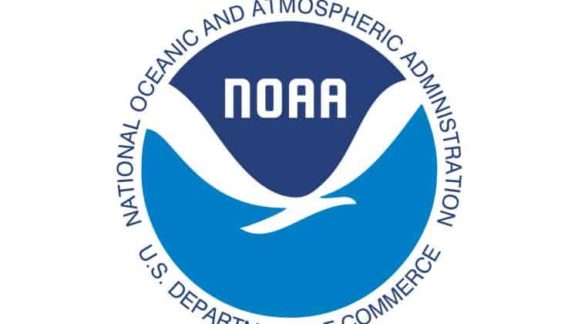
The New York Times on October 27 ran an article titled “As Election Nears, Trump Makes Final Push Against Climate Science.” The article spotlights President Trump’s recent appointments of three scientists—Dr. Erik Noble, Dr. Ryan Maue, and Dr. David Legates—to leadership positions at the National Oceanic and Atmospheric Administration (NOAA), where they now serve, respectively, as chief of staff, chief scientist, and deputy assistant secretary.
The three appointees have “questioned accepted facts about climate change” and “threaten to stifle a major source of objective United States government information about climate change that underpins federal rules on greenhouse gas emissions,” we are told. Indeed, according to the Times, the appointees’ “primary goal is to undercut the National Climate Assessment,” the multi-agency quadrennial review of U.S. climate change impacts. The Times elaborates:
The assessment, a report from 13 federal agencies and outside scientists led by NOAA, which the government is required by law to produce every four years, is the premier American contribution to knowledge about climate risks and serves as the foundation for federal regulations to combat global warming. The latest report, in 2018, found that climate change poses an imminent and dire threat to the United States and its economy.
The next iteration of the Assessment could be very different from its predecessors. But that is “against climate science” only if previous assessments were “objective” presentations of “accepted facts.” In fact, they were works of sophistry. Yes, the reports contained vast amounts of real information. But they also ignored lots of information that does not fit the “worse than we thought” narrative. Moreover, the big takeaways in the 2018 Assessment were shaped by overheated climate models, an inflated baseline emission scenario, and the absence of any acknowledgement that American society is expected to keep getting healthier and wealthier over the next 80 years regardless of climate change.
In short, a swamp draining at NOAA is long overdue. A better title for the Times article would be: “As election nears, Trump makes new push for quality control in climate science.”
Sophistry in the 2018 Assessment
In the excerpt above, the link is to a Times article published on the release date of the 2018 Assessment (November 23, 2018). Titled “U.S. Climate Report Warns of Damaged Environment and Shrinking Economy,” the opening paragraph reads:
A major scientific report issued by 13 federal agencies on Friday presents the starkest warnings to date of the consequences of climate change for the United States, predicting that if significant steps are not taken to rein in global warming, the damage will knock as much as 10 percent off the size of the American economy by century’s end.
How did the Assessment authors arrive at that prediction? The Times did not explain. Did the reporters even bother to inquire? Unknown.
The Assessment’s methodology is far from obvious. Chapter 29 purports to tote up climate damages by sector but total annual damages in 2090 come to just under $500 billion. That’s not chump change, but it comes to just 2.3 percent of the $21.44 trillion U.S. GDP in 2019. Most experts expect the U.S. GDP to be substantially larger than that 80 years from now (h/t Ron Bailey).
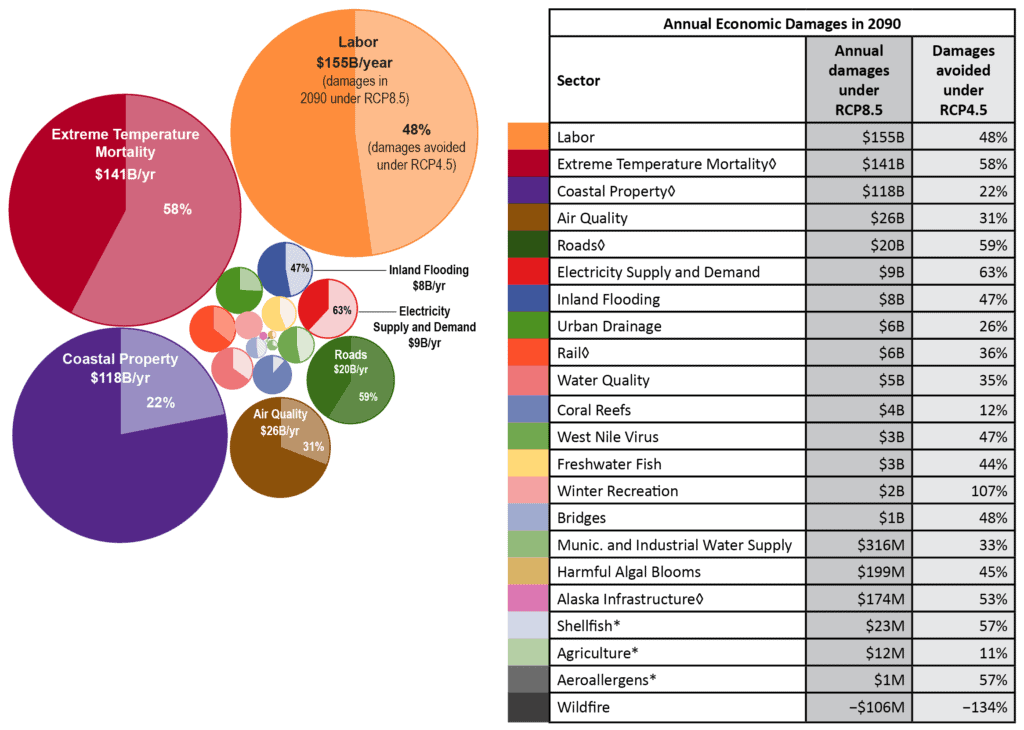
Curiously, the 10 percent GDP loss estimate is nowhere stated in the text of the 2018 Assessment. Rather, it is depicted in a chart. The chart (righthand figure below) shows U.S. GDP declining by 10 percent if global average temperatures in 2080-2099 are 11°F (8°C) higher than in 1980-2010.

The gray text box explains that figure is adapted from a study by Hsiang et al. (2017). Below is the figure as it appears in that study. The numbers on the horizontal axis are degrees Celsius of global warming from 2000 to 2100.
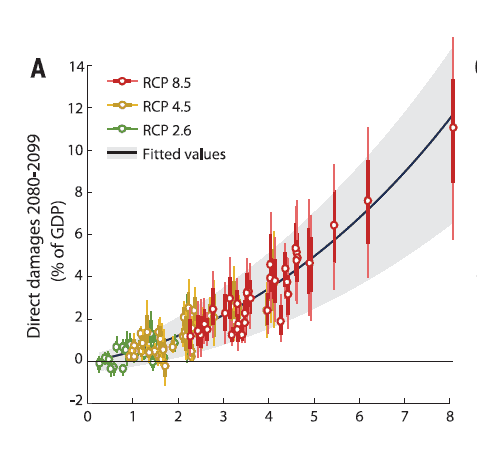
An 8°C warming by century’s end is not credible. The linear warming trend over the past 40-plus years is +0.14°C per decade. Sure, that could change, but even if the rate suddenly tripled, the rise in global average temperature by 2100 would still be less than half (3.36°C) the amount in the Assessment’s scary “prediction.”
When someone claims something very bad could happen, curious people usually ask how likely it is that it will happen. Neither the Assessment nor the Times seemed to think that was of any interest to the public. Yet Hsiang et al. did address that question in another figure—a figure the Assessment did not see fit to include or adapt.

The figure above shows the probability distribution of global warming projections when an ensemble of climate models called CMIP5—the same collection of models used by the United Nations’ Intergovernmental Panel on Climate Change (IPCC) in its Fifth Assessment Report—are run with an emission scenario called RCP8.5.
A brief explanation may be helpful here. RCP8.5 is one of four “representative concentration pathways” (RCPs) used in the IPCC’s Fifth Assessment Report and one of two used in the 2018 U.S. National Climate Assessment. RCPs are called “pathways” because they plot the trajectory of greenhouse gas emissions, concentrations, and resulting changes in radiative forcing over a period of decades to centuries. “Radiative forcing” may be defined as the difference between the amount of solar energy absorbed by the Earth and the amount radiated back to space. Forcing is measured in watts per square meter. Thus, RCP8.5 is the emissions trajectory in which radiative forcing increases by 8.5 W/m2 during 2000-2100. Finally, RCP’s are called “representative” because at least some scenarios in the socioeconomic development literature have similar forcing characteristics.
The first thing to notice in the Hsiang et al. figure above is that when the CMIP5 models are run with RCP8.5, only one out of 100 model runs forecasts a warming as high as 8°C. So, the odds of that happening are pretty darn low. Neither the Assessment nor the Times thought that was worth mentioning.
The probability that global warming will reach 8°C by 2100 is actually lower than 1 percent because the CMIP5 model ensemble injects a significant warming bias into climate impact assessments, as does the use of RCP8.5 as a business-as-usual emission scenario.
On average, the CMIP5 models hind-cast two to three times more warming in the bulk tropical atmosphere during 1979-2017 than actually occurred. A reasonable inference is that the models are tuned too hot and will continue to overshoot observed warming in the future.
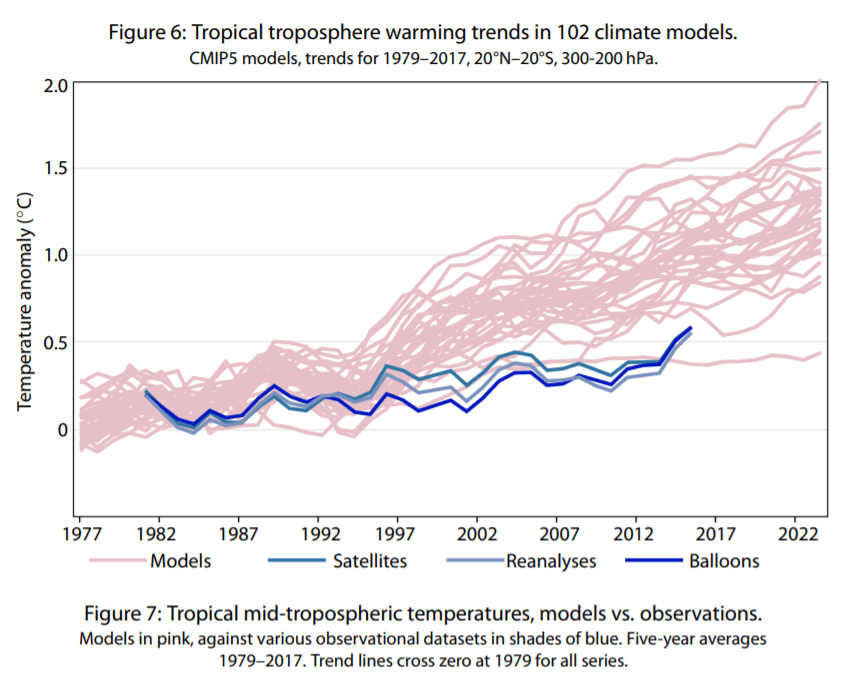
Although often billed as a business-as-usual scenario, RCP8.5 is actually a high-end emissions scenario. It assumes the kind of forcing trajectory that would emerge if coal scaled up rapidly to provide almost half of global energy from all sources by 2100.
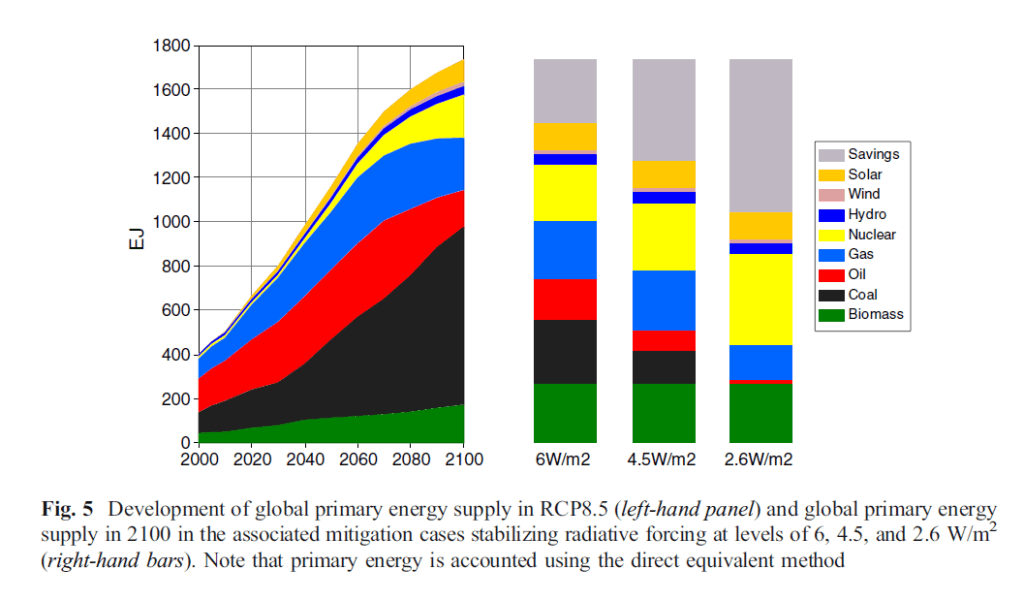
Coal has not provided that large a share of global primary energy since 1940. Many climate campaigners claim renewables already are (or soon will be) cheaper than fossil fuels. Yet RCP8.5 is plausible only if the world returns to coal.
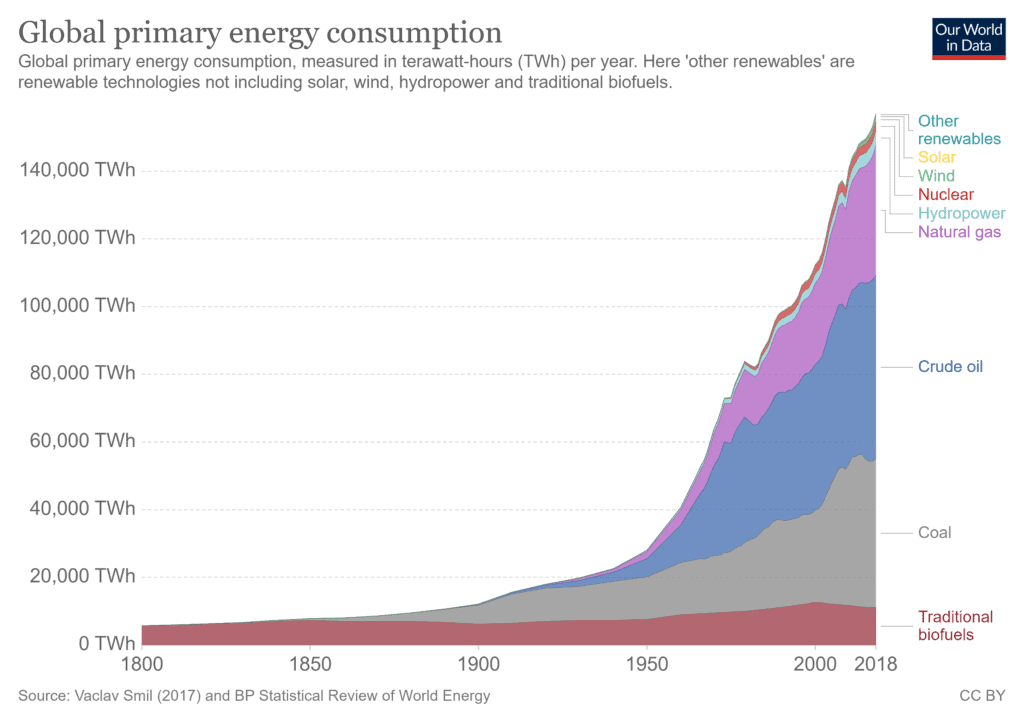
In short, the National Climate Assessment ran a group of overheated models with an inflated emissions baseline. Yet, even with that biased combo, global warming hits 8°C in only 1 percent of model projections. With more realistic models and emission scenarios, the probability would be even lower. It is an implausible worst-case scenario.
The Assessment, of course, gave the exact opposite impression, as did the Times, that we rush to our doom unless Obama-era climate policies are retained. That is not science. It is propaganda.
Alas, the bamboozle did not end there. Neither the Assessment nor the Times clarified that even if global warming knocks down GDP by 10 percent in the 2090s, people will still be much wealthier and healthier than they are today. That is not a prognostication of the Trump administration or the Heritage Foundation. It is projection of top-tier climate scientists affiliated with the IPCC.
In addition to developing RCPs to provide forcing trajectories for climate impact assessments, climate researchers also develop “shared socio-economic pathways” (SSPs) to estimate how emissions might increase under different economic development scenarios. Riahi et al. (2017), a study by 16 mainstream experts from prestige research institutions in eight countries, finds that, in 2100, global per capita GDP is projected to be greater and income inequality lower in the IPCC’s fossil fuel-intensive socioeconomic pathway (SSP5) than in all other SSPs, including the “green road/sustainable” pathway (SSP1). Below are the pertinent charts from that study:
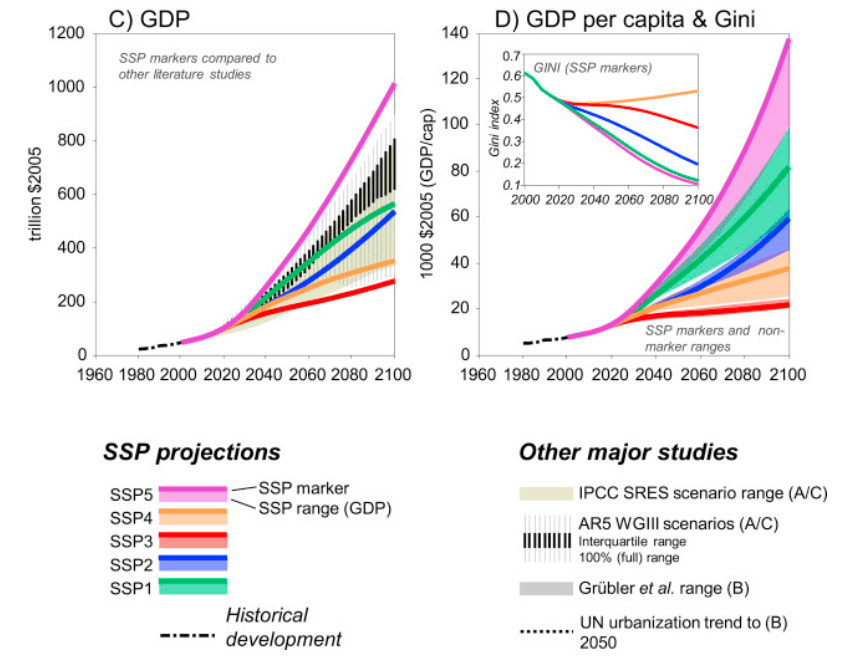
SSP5 has a radiative forcing pathway as high as that in RCP8.5. Yet in SSP5, global per capita GDP in 2100 is 10-fold greater than it was in 2000, and the gap between rich and poor countries is smaller than at any time in history. Somehow that “finding” by IPCC-affiliated experts did not make it into the 1,656-page Assessment.
Sophistry in Earlier Assessment Reports
A shakeup of NOAA’s climate program leadership would be fully justified even if the 2018 Assessment’s hoodwinks were a one-time fluke. However, the first three assessment reports (published in 2000, 2009, and 2014) were also agenda-driven products, tailored to instill fear in the service of regulatory ambition.
My colleague Patrick Michaels and co-author Paul C. Knappenberger lay out the involuted details in Chapter 21 of their 2016 book Lukewarming: the New Climate Science that Changes Everything. Michaels concisely summarizes the defects in his 2019 book, Scientocracy: The Tangled Web of Public Science and Public Policy:
All three National Assessments were deeply flawed. The first broke the normative rule that models should be used for public policy only if they have explanatory capability. The second was so incomplete that it could be fodder for an entire palimpsest with nearly twice as many referenced citations, and the third was specifically designed as part of the Obama administration’s policy thrusts on climate change.
Having rolled back President Obama’s signature climate policies—the so-called Clean Power Plan, the deputizing of California to determine national fuel economy standards, and the Paris Climate Treaty—President Trump apparently has decided the time is right for federal agencies to take a fresh look at climate change. To oversee that project, he has appointed scientists who are not beholden to the Climate Regulatory Complex, who cannot be intimidated by the cancel culture, and who cannot be fooled by computer-aided sophistry.
An era of more objective, balanced, and candid U.S. government climate change assessments would help create a healthier political climate for economic liberty, our constitutional system of separated powers, our First Amendment freedoms of speech and press, and the tone and quality of civil discourse.